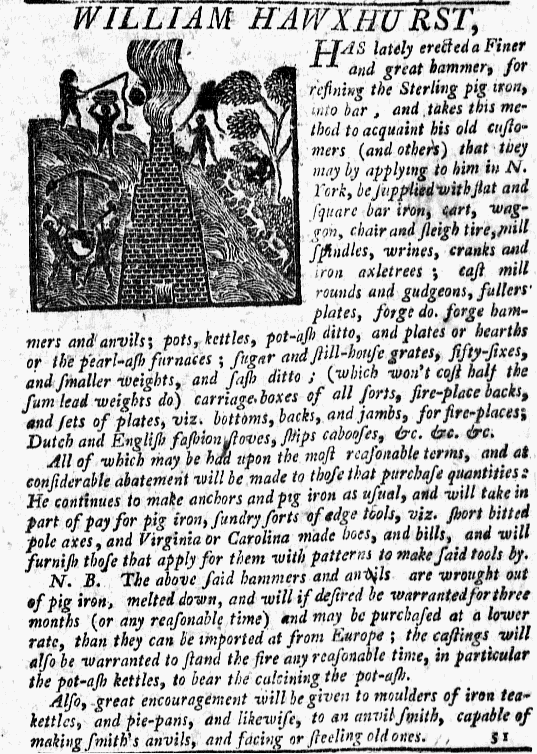What was advertised in a colonial American newspaper 250 years ago today?

“WILLIAM HAWXHURST, HAS lately erected a Finer and great hammer, for refining the Sterling pig iron, into bar.”
By the end of January 1767 William Hawxhurst had been placing this advertisement – with its detailed woodcut – in the New-York Journal for several weeks. The woodcut depicts a furnace “for refining he Sterling pig iron, into bar” surrounded by five workers undertaking several tasks. To the right, three pack animals seems to be loaded with supplies to deliver to Hawxhurst. With the exception of the stock images in notices for slave auctions or runaway slaves and indentured servants, few woodcuts in eighteenth-century advertisements depicted people. Andrew Gautier’s advertisement in the same issue of the New-York Journal, for instance, included a woodcut of a Windsor chair, giving potential customers a glimpse of the product offered for sale rather than the artisan who produced it. Hawxhurst testified to the industriousness of American colonists by showing men at work.
Hawxhurst also offered assurances about his domestically produced iron and the array of products made from it. He promised “reasonable terms” and a “considerable abatement … to those that purchase quantities.” He also offered a guarantee, pledging that his hammers and anvils were “warranted for three months (or any reasonable time).” In addition, “the castings will also be warranted to stand the fire any reasonable time.” He even compared his iron goods he produced favorably to any “imported … from Europe,” stating customers could purchase from him “at a lower rate.” Hawxhurst combined an image of American industriousness with guarantees about the quality of his merchandise and comparisons to the prices of European imports as he encouraged potential customers to purchase items manufactured locally. Although he did not make any explicitly political comments in his advertisement, these attributes fit within marketing discourses developed by the first generation of advertisers who adopted “Buy American” campaigns during the imperial crisis that preceded the American Revolution.
As an aside, I am pleased to finally share this advertisement with readers of the Adverts 250 Project. The woodcut has drawn my attention, as it must have drawn the attention of eighteenth-century readers, every time it appeared in the New-York Journal. However, no previous iterations of this advertisement included an image of the woodcut clear enough to merit inclusion in the project. For the 1760s, it was an exceptionally detailed image, one executed by an artist of modest abilities. Between the original printing and poor photography much later, the woodcut often appears as a dark square in the digitized surrogates available to modern historians. I made a deliberate decision not to examine this advertisement until it featured an image that did justice to the original woodcut.
For more on William Hawxhurst’s advertising efforts, see his public dispute with competitor Daniel Offley in Philadelphia.
